Figure 1.
Exposure of mice to 2 h noise (8–16 kHz, 100 dB SPL) induced 30–40 dB of permanent threshold shift measured 7 d after the exposure (filled circles). Plotted are means ± SE. The amount of threshold shift was reduced when the noise was preceded by a 12 h period of restraint stress (filled triangles; p < 0.001 by ANOVA) or when the mice were given dexamethasone (0.5 mg/kg, i.p.) either immediately before (open diamonds; p < 0.005 by ANOVA) or after (open squares; p < 0.001 by ANOVA) the noise exposure. Restraint stress was performed on 6-week-old B6 mice, the background strain for the luxoid mutant (see Fig. 4). Dexamethasone experiments were performed on 10- to 12-week-old CB mice. Threshold shifts were obtained by subtracting thresholds following noise exposure from those of unexposed animals. Noise-only shifts for 6 week B6 and 10–12 week CB were similar and were combined here for display purposes. Individual plots for dexamethasone effects in CB mice and restraint stress effects in B6 mice are presented as supplemental Figure 1 (available at www.jneurosci.org as supplemental material).

